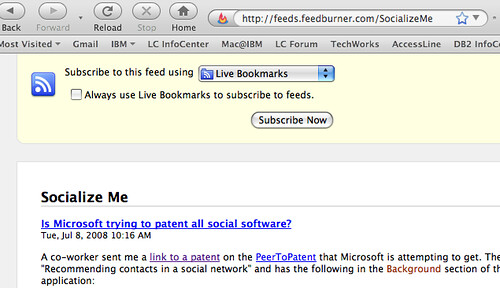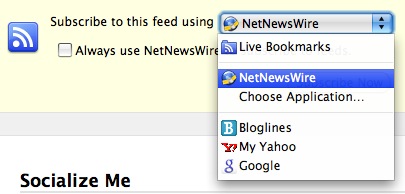 This past Monday (yes, I know I'm late, but Monday was a holiday and I took Friday off too) the remote Lotus Connections Customization RedWiki was officially kicked off with a call at 7:30am EDT(to accommodate our international team).
This past Monday (yes, I know I'm late, but Monday was a holiday and I took Friday off too) the remote Lotus Connections Customization RedWiki was officially kicked off with a call at 7:30am EDT(to accommodate our international team).
According to the ITSO team, this has been the most popular residency so far, in terms of applicants. A residency had never had so many applicants in so little time before. I believe this goes to show the great interest and passion out there for Lotus Connections. And that feels good! 
Here's a snapshot of the introductory note:
 The goal of this ITSO project is to create entries in the current online Lotus Connections Wiki that will enable customers and business partners to allow Lotus Connections and 3rd party applications (including IBM and Lotus apps) to interface. We have come up with a list of ideas on how that can be done and you have signed up for working on these. We will finalize that list during a conference call in the first week.
The goal of this ITSO project is to create entries in the current online Lotus Connections Wiki that will enable customers and business partners to allow Lotus Connections and 3rd party applications (including IBM and Lotus apps) to interface. We have come up with a list of ideas on how that can be done and you have signed up for working on these. We will finalize that list during a conference call in the first week.
An interesting and unusual aspect of this project is that your work will take place on a live wiki that everyone in the world can view and even edit. (Since people must log in to view and edit, we will have change tracking by ID available, and the wiki has rollback capability.) The project sponsors and I feel that this aspect nicely captures the beauty of a wiki atmosphere, where the world can watch information being created, collected, and stored and even help out as appropriate.
Core team members:
- Mike Ebbers - ITSO Project Leader, New York
- Dean Jesson - IT Specialist, Germany
- Jun Liu - Atlas for Lotus Connections Team Lead, China
- Torsten Hoffman - IT Specialist Web 2.0 & Social Software, Germany
- Shu Sia Lukito - Sr. IT Specialis, Maryland
- Sergio Imperial - IT Specialist, Portugal
- Marcus Smith - IT Specialist, Illinois
- Amit Kumar - IT Specialist, India
- Zhou Lin Dai - Software Engineer, China
- Jamie O'Leary - Lotus Connections Home page developer, Ireland
- Chirag Barhate - Software Engineer, India
Key Lotus Sponsors / Stakeholders:
- Jennifer Heins - Lotus Technical Content Strategist and Architect, Cambridge
- Sal Mazzotta - Lotus Applications Architect, Cambridge
- Luis Benitez - Consulting Social Software Specialist, Puerto Rico (but you should know this)
- Suzanne Minassian - Lotus Connections Product Manager, Boston
- Jack Downing - Information Architect (Lotus Sametime & Lotus Symphony), Cambridge
- Mac Guidera - Tech Lead for Lotus Greenhouse, Orlando
Let's get going! Oh and in case you are wondering... yes, we are using Lotus Connections Activities to manage this project.
 Last Monday, I took the last flight into New York for a 10am meeting on Tuesday with a customer in Manhattan. That meant that I got into the hotel at about 1am
Last Monday, I took the last flight into New York for a 10am meeting on Tuesday with a customer in Manhattan. That meant that I got into the hotel at about 1am  . After checking in, I got into the elevator with two other women who looked like they were just coming from a big party. They were going to the 14th floor. I was going to the 19th floor.
. After checking in, I got into the elevator with two other women who looked like they were just coming from a big party. They were going to the 14th floor. I was going to the 19th floor.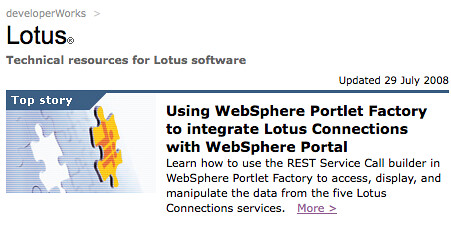
 This is a "repost" (is that the right term) of
This is a "repost" (is that the right term) of 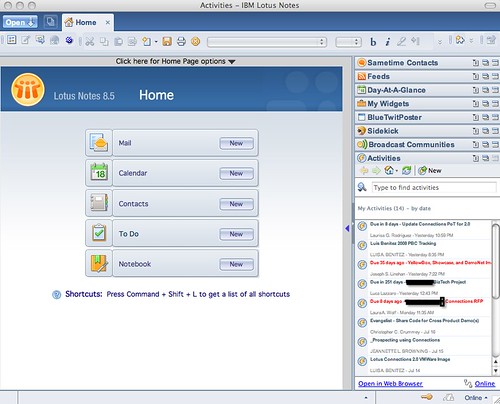
 First, a little history. When
First, a little history. When  Anyway, I considered myself pretty successful at that project up until May of this year. With
Anyway, I considered myself pretty successful at that project up until May of this year. With  Today, I mostly depend on two main applications: a Feed Reader (NetNewsWire) and my mail client (Lotus Notes v8.5 -- the public beta). My feed reader is my new inbox. Just like my good friend Mr. Suarez,
Today, I mostly depend on two main applications: a Feed Reader (NetNewsWire) and my mail client (Lotus Notes v8.5 -- the public beta). My feed reader is my new inbox. Just like my good friend Mr. Suarez,  (like my friend Laurisa Rodriguez says).
(like my friend Laurisa Rodriguez says).
 Don't you hate it when you get an email with an attachment that's 200TB? I think you will all agree and say yes. It's annoying. So how do we fix it? Easy, modify the mail client so that it allows attachments only up to 1MB. Right ?
Don't you hate it when you get an email with an attachment that's 200TB? I think you will all agree and say yes. It's annoying. So how do we fix it? Easy, modify the mail client so that it allows attachments only up to 1MB. Right ? The other day I discovered
The other day I discovered 

 Here's how it would look if a blog entry had 3 recommendations and you haven't recommended it yet. If you hover over the star you get to see who has recommended it so far, easily giving you visibility to other people with your similar interests!
Here's how it would look if a blog entry had 3 recommendations and you haven't recommended it yet. If you hover over the star you get to see who has recommended it so far, easily giving you visibility to other people with your similar interests!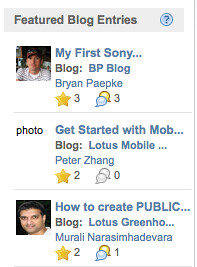 Then, based on the number of recommendations and the number of comments of a particular entry it can become a 'Featured Blog Entry' and is listed right on the Blogs landing page. But as time goes by, a particular blog entry's recommendations may grow to infinity
Then, based on the number of recommendations and the number of comments of a particular entry it can become a 'Featured Blog Entry' and is listed right on the Blogs landing page. But as time goes by, a particular blog entry's recommendations may grow to infinity 

